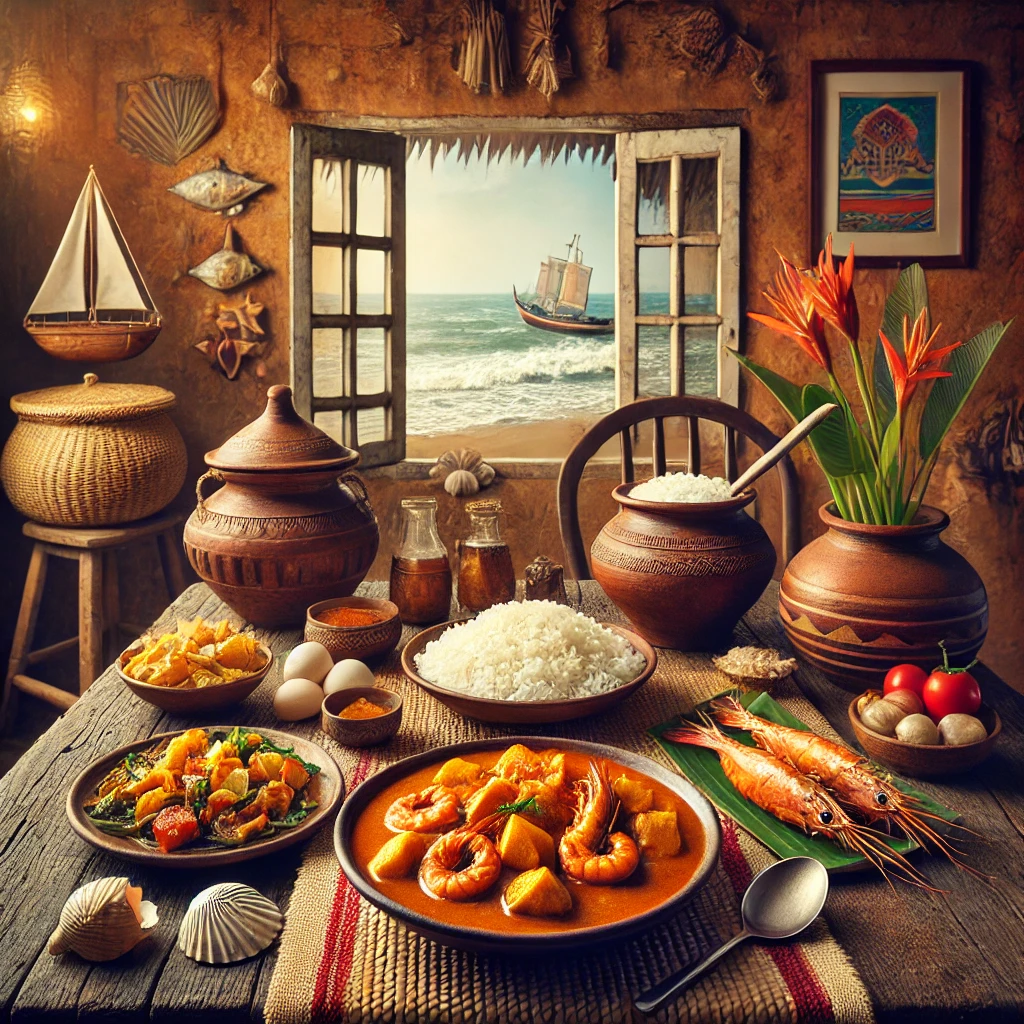Goan prawn curry is a traditional seafood dish from Goa, a coastal state in India. It features prawns cooked in a tangy, spicy, and creamy coconut-based gravy, typically flavored with tamarind, chilies, and a blend of aromatic spices. Known for its rich and bold flavors, the dish is usually enjoyed with steamed rice or traditional Goan bread.
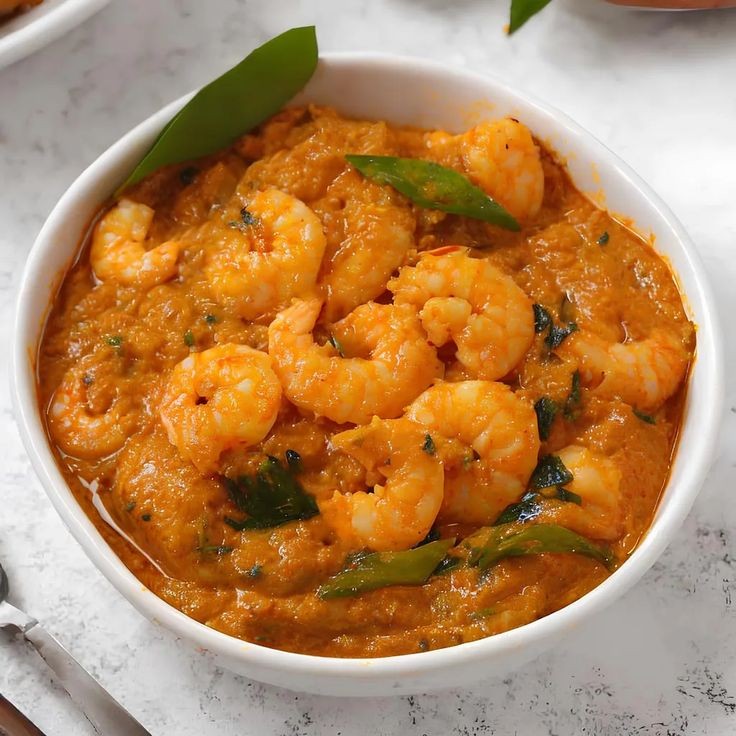
History
Goan prawn curry has deep roots in the culinary heritage of Goa, a state on the western coast of India known for its unique blend of Indian and Portuguese influences. Goa was a Portuguese colony for over 450 years (from 1510 to 1961), and this long period of colonization left a significant mark on its cuisine.
Historical Background:
1. Indigenous Roots: Before the Portuguese arrived, Goan cuisine was primarily influenced by the local Konkani culture, which centered on rice, coconut, seafood, and locally grown spices. The coastline provided an abundance of fresh prawns, crabs, and fish, which were staples in everyday meals.
2. Portuguese Influence: The Portuguese introduced various ingredients and cooking techniques to Goa, including the use of vinegar, tomatoes, and chilies. Chilies, which are now a crucial part of Goan prawn curry, were brought from the Americas by the Portuguese. Tamarind, another key ingredient, was already used in regional dishes but gained more prominence due to Portuguese influence.
3. Hindu and Catholic Culinary Traditions: Goan prawn curry has variations based on religious and community traditions. The Hindu version often uses kokum (a sour fruit) instead of tamarind and avoids vinegar, while the Catholic version, influenced by Portuguese cuisine, incorporates vinegar and a more liberal use of spices.
Significance:
Seafood Culture: Goa’s fishing culture and its proximity to the Arabian Sea make seafood, especially prawns, a vital part of the diet.
Fusion Cuisine: The dish symbolizes the fusion of Indian and European flavors, showcasing how local ingredients were adapted to foreign techniques.
Global Appeal: Over the years, Goan prawn curry has gained popularity worldwide, representing the rich, multicultural heritage of Goan cuisine.
This dish is more than just a meal—it’s a testament to Goa’s historical journey and the blending of diverse cultures.
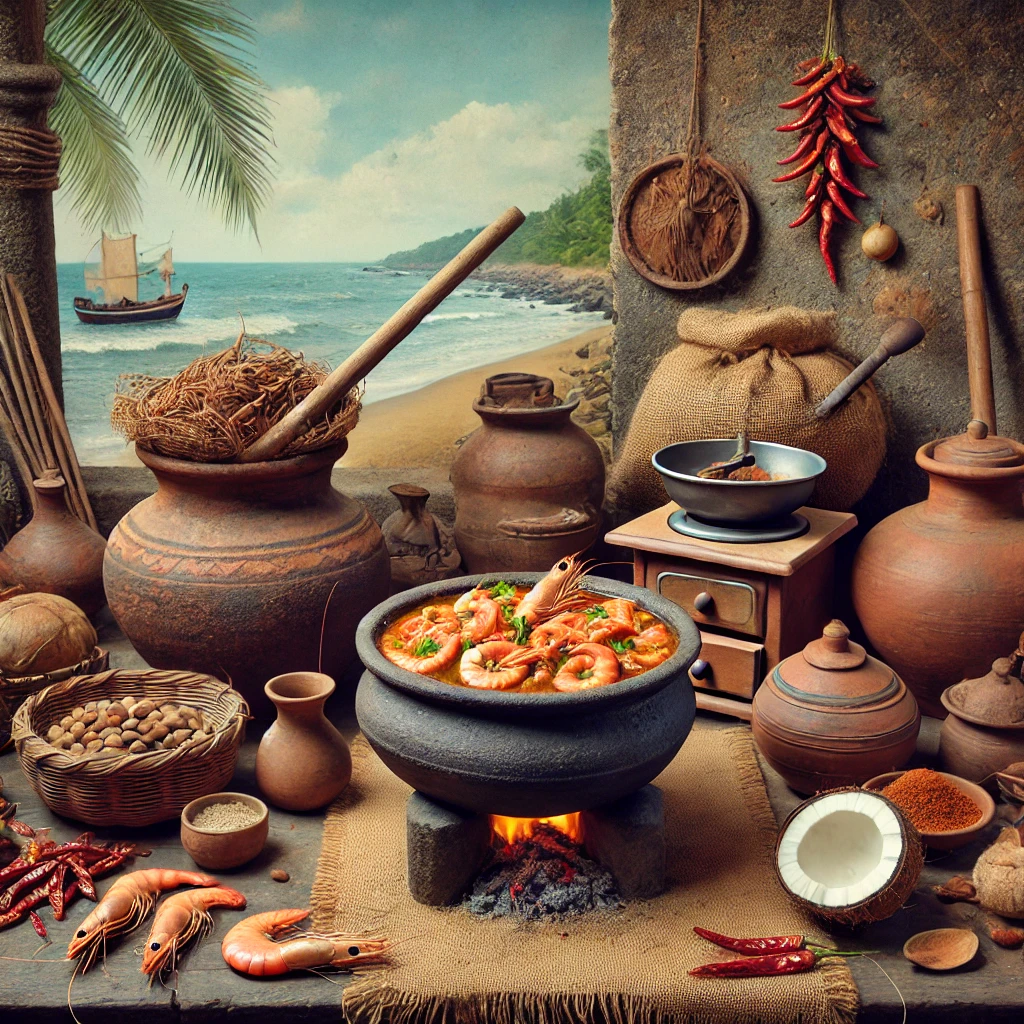
Taste Description
Goan prawn curry offers a vibrant and complex blend of flavors, making it a distinctive and memorable dish. Here’s a breakdown of its taste profile:
1. Tangy and Sour: The tanginess primarily comes from tamarind or kokum, giving the curry a zesty, slightly sour undertone. This sourness balances the richness of the coconut milk.
2. Creamy and Rich: The use of coconut milk creates a smooth, velvety texture and adds a mild sweetness that tempers the heat of the spices.
3. Spicy and Warm: The dish has a moderate to high level of heat from red chilies and green chilies, creating a warming sensation without overwhelming the palate.
4. Aromatic and Earthy: A blend of spices like cumin, coriander, mustard seeds, and turmeric imparts earthy, aromatic flavors. The ginger-garlic paste adds depth and complexity.
5. Umami and Briny: The prawns themselves add a natural umami and briny flavor, enhancing the overall savoriness of the curry.
Together, these elements create a harmonious balance—spicy yet creamy, tangy yet savory. It’s typically enjoyed with steamed rice, which helps soak up and balance the intense, bold flavors.
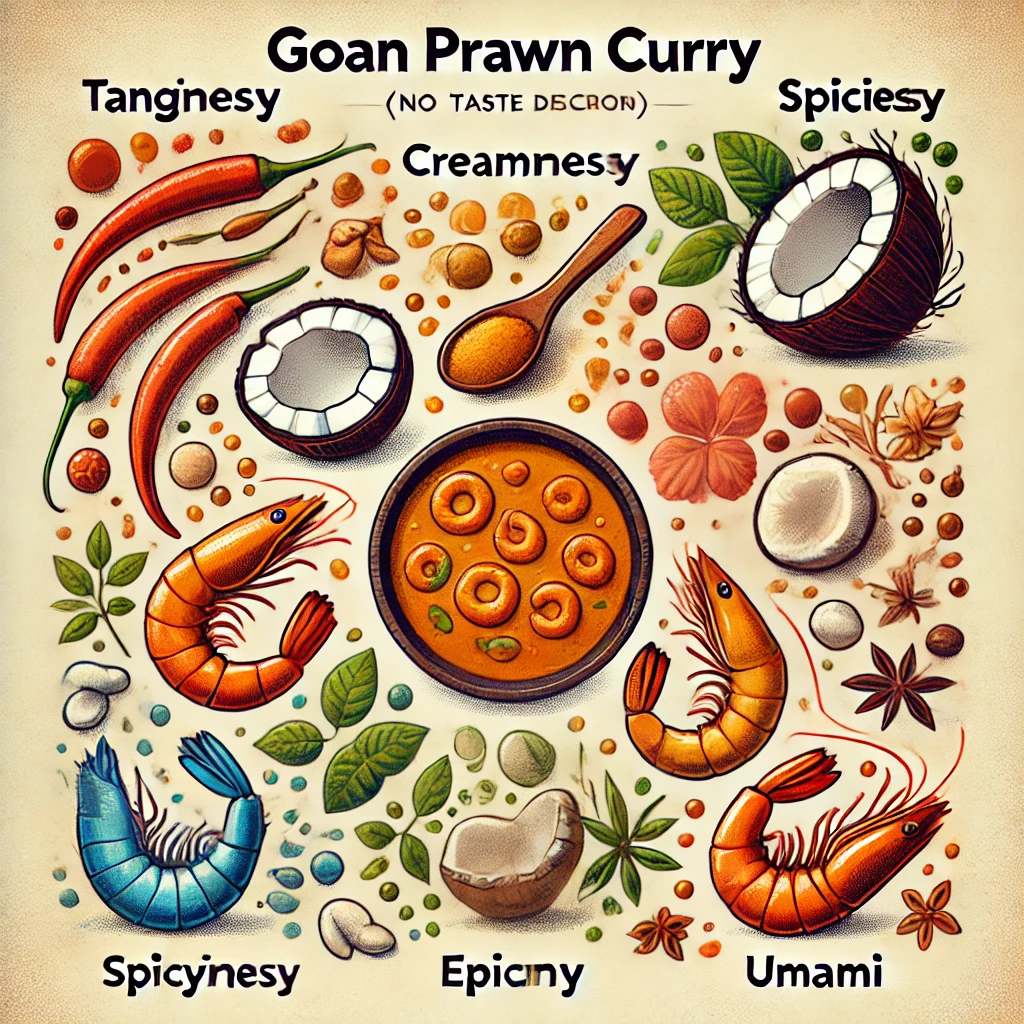
Recipe
Ingredients
For the Curry Paste:
1 cup grated coconut (fresh or desiccated)
4-5 dried red chilies (Kashmiri for color, spicy for heat)
1 tbsp coriander seeds
1/2 tsp cumin seeds
4-5 black peppercorns
3-4 cloves garlic
1 small onion, chopped
1 small piece of tamarind (about 1 tbsp pulp)
1/2 tsp turmeric powder
Water as needed
For the Curry:
300 gms prawns, cleaned and deveined
1 medium onion, finely chopped
1 green chili, slit
1 tomato, chopped
1 tbsp coconut oil (or any oil)
Salt to taste
Water as needed
Fresh coriander leaves for garnish
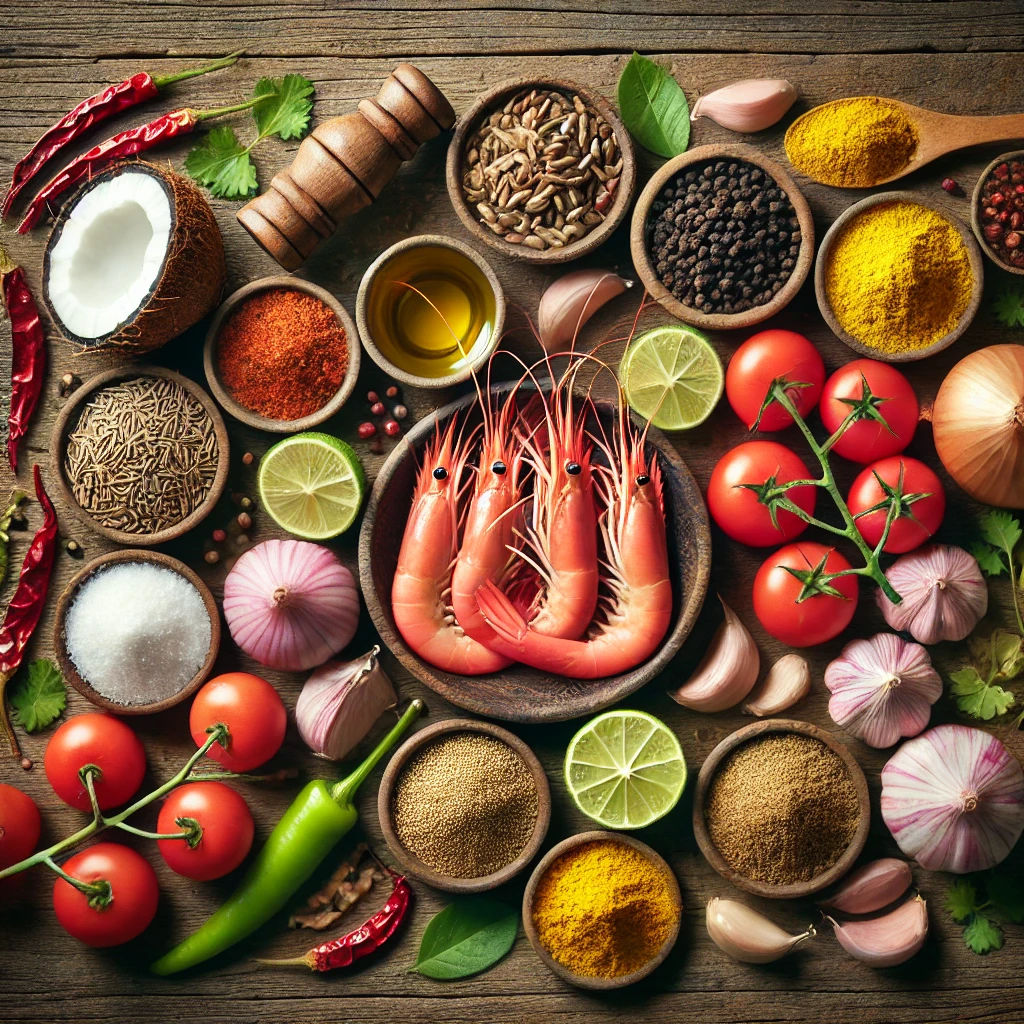
Instructions:
1. Make the Curry Paste:
In a blender, add grated coconut, dried red chilies, coriander seeds, cumin seeds, black peppercorns, garlic, chopped onion, tamarind, and turmeric powder.Add a little water and grind into a smooth paste. Keep aside.
2. Prepare the Curry:
Heat coconut oil in a pan. Add the chopped onions and green chili, sauté until the onions turn translucent.Add the chopped tomatoes and cook until soft and mushy.Pour the ground curry paste into the pan and add some water to achieve the desired consistency. Bring it to a gentle boil.Season with salt to taste.Add the cleaned prawns and simmer for 5–7 minutes until they are cooked through. Prawns cook quickly, so avoid overcooking.
3. Garnish and Serve:
Garnish with fresh coriander leaves.Serve hot with steamed rice or Goan poi (bread).
Tips:
• Adjust the number of chilies based on your spice preference.
• If you like a tangier curry, add a bit more tamarind pulp.
• Fresh coconut enhances the authentic Goan flavor, but desiccated coconut works if unavailable.
Nutritional Value
Goan Prawns Curry is not only delicious but also nutritious. The prawns provide lean protein, essential for muscle growth and repair. Coconut contributes healthy fats, mainly medium-chain triglycerides (MCTs), which can boost energy and support heart health. Spices like turmeric and cumin are rich in antioxidants and have anti-inflammatory properties. The curry also offers vitamins like B12 from prawns and minerals like potassium, magnesium, and iron from the spices. Overall, it’s a balanced dish that can be enjoyed as part of a healthy diet.
Personal Experience
As someone sharing from a Goan perspective, Goan Prawns Curry is more than just a meal—it’s a taste of home. Growing up in Goa, this dish would often be the centerpiece of a family lunch, especially on Sundays or festive occasions. The aroma of freshly ground coconut and spices simmering on the stove is unmistakable and instantly comforting.Prawns are abundant along the Goan coastline, and each family has its own variation of this curry, passed down through generations. Some prefer it spicier, while others add a hint of sweetness using jaggery. The tanginess usually comes from kokum or tamarind, balancing the rich, creamy coconut gravy.We usually enjoy it with steaming hot rice, accompanied by fried fish or a simple vegetable stir-fry. For Goans, this curry is not just food; it’s a reminder of shared meals, coastal breezes, and the lively spirit of the region. If you’ve ever sat in a beach shack watching the sunset while savoring this curry, you’ll know that it’s a memory that lingers.
